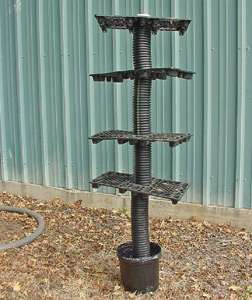
MONROE, La. — Louisiana fisheries biologist Mike Wood watched in the 1990s as the state's premier trophy bass lake crashed after grass carp denuded the reservoir of vegetation, and by 1998 he decided something had to be done.
"The lake was harvested before being filled up, so there was no standing timber," the Louisiana Department of Wildlife & Fisheries (DWF) biologist told BASS Times. "When the vegetation was gone, it was just barren, open Atlantic Ocean out there. The fish just scattered and were hard to find.
"We were really in a fix trying to get some kind of cover in there."
Wood experimented with various kinds of artificial reefs, creating reefs using wooden pallets, brush, trees and tires.
None of them were very durable, but Wood soon came up with a solution.
"The Nutrena Feeds Plant in Lacompte (La.) was paying someone to haul off plastic pallets," he explained. "They were perfect: They've got a hole right in the middle, and it's a perfect fit for a 3-inch plastic pipe."
The result was the development of "trees" formed from the 15-inch by 24-inch pallets spaced along a length of pipe.
"I've made them as short as 2 feet and as long as 20 feet," Wood said.
And they are extremely inexpensive, he said. "The pallets are free," Wood explained. "The concrete, PVC, flexible plastic pipe and other material costs about $6 to $9 per structure, depending on how high you make it."
The resulting artificial reefs have proved to be extremely durable and effective, and the idea has spread to other lakes across the state. Currently, hundreds of the plastic structures litter the bottom of eight lakes, providing structure around which bass and baitfish can congregate.
"Every fish from the time it hatches is looking up for danger," Wood said. "So they all have a tendency to get under something. These structures allow them to get under the pallets and feel safe."
The reefs' effectiveness is optimized by grouping the structures. For instance, one of the Caney Lake reefs includes 600 pallets over a one acre area.
Similar groupings have been used on lakes D'Arbonne, Bruin, Toledo Bend, Cross, CLECO, Sibley, Caney and Clairborne. Each reef is marked with a bright orange buoy so anglers can locate them.
DWF biologist Ricky Yeldell periodically dives the reefs placed along the Louisiana side of Toledo Bend, and he's found that fish set up shop on them just like they do natural structure.
"If you go out and put out a dozen, you're going to have three or four that fish love, two or three that are so-so and some that are dead as a hammer," Yeldell said.
What he's found on his diving trips has prompted him to plan an expansion of the program from the current 17 reefs on Toledo Bend.
"I plan to put some out that I don't advertise," Yeldell said. "They're just going to be out there doing what they're designed to do: provide cover for bass."
Wood said reefs also could be established in other lakes, with the priority going to those that have lost structure to age.
"We have a lot of lakes that just don't have the woody structure anymore," he said. "It's just rotting away."

